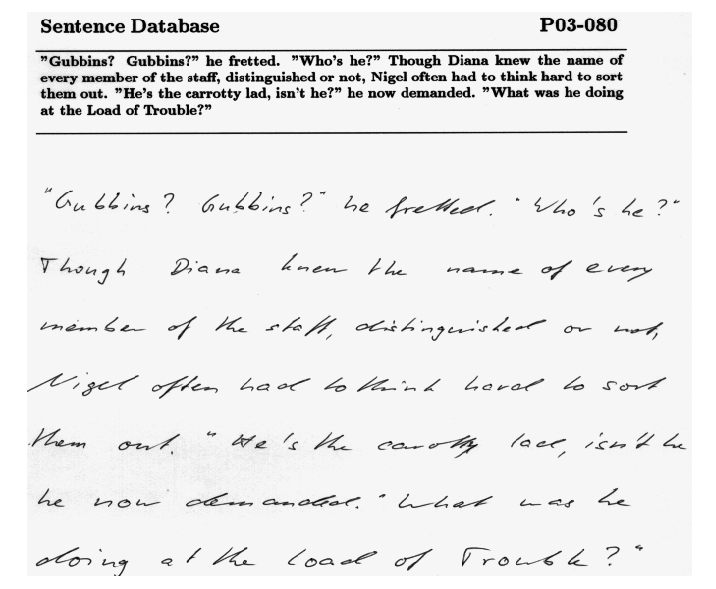从图像到精准文字:基于PyTorch与CTC的端到端手写文本识别实战
在数字化时代,手写文本识别(Handwritten Text Recognition,HTR)作为人工智能领域的重要研究方向之一,广泛应用于文档数字化、历史资料保存、自动化数据录入等多个领域。本文将深入探讨如何利用 IAM 手写数据库(IAM Handwriting Database)构建一个高效、准确的手写文本识别系统,采用 PyTorch 框架,并结合 Connectionist Temporal Classification(CTC)损失函数进行训练和推理。
一、IAM 手写数据库简介
IAM 手写数据库是一个广泛使用的英文手写文本数据集,包含了多位作者手写的文本样本。该数据库提供了丰富的手写行图像及其对应的文本标注,适用于训练和评估手写文本识别模型。
IAM 手写数据库官网:https://fki.tic.heia-fr.ch/databases/iam-handwriting-database

二、构建手写文本识别模型
PyTorch 官方网站:https://pytorch.org/
Gradio 官方网站:https://gradio.app/
1. 数据预处理
在使用 IAM 数据库进行训练之前,首先需要对数据进行预处理。这包括读取图像文件、解析标注文件、进行图像尺寸调整和归一化处理等。特别地,对于标注文件中的 | 字符,应替换为空格,以确保标签的正确性。
def parse_annotations(anno_path="/content/lines.txt"):pairs = []with open(anno_path, "r", encoding="utf-8") as f:for line in f:if line.startswith("#"): # 跳过注释continueparts = line.strip().split(" ")if parts[1] != "ok": # 有些行无效continueline_id = parts[0]subdir = line_id[:3]subsub = line_id[:7]img_path = f"/content/lines/{subdir}/{subsub}/{line_id}.png"if os.path.exists(img_path):text = " ".join(parts[8:])text = text.replace("|", " ") # 替换为真实空格pairs.append((img_path, text))return pairs
2. 模型架构设计
构建手写文本识别模型时,常采用卷积神经网络(CNN)与循环神经网络(RNN)的结合。CNN用于提取图像特征,RNN用于序列建模,CTC 损失函数用于处理输入与输出长度不一致的问题。以下是一个基于 PyTorch 的模型示例:
import torch
import torch.nn as nnclass CRNN(nn.Module):def __init__(self, num_classes):super().__init__()self.cnn = nn.Sequential(nn.Conv2d(1, 64, 3, 1, 1), nn.ReLU(), nn.MaxPool2d(2,2),nn.Conv2d(64,128,3,1,1), nn.ReLU(), nn.MaxPool2d(2,2),nn.Conv2d(128,256,3,1,1), nn.ReLU(),nn.Conv2d(256,256,3,1,1), nn.ReLU(), nn.MaxPool2d((2,1)))self.rnn = nn.LSTM(256*4, 256, bidirectional=True, num_layers=2, batch_first=True)self.fc = nn.Linear(512, num_classes)def forward(self, x):x = self.cnn(x) # (B, C, H, W)b,c,h,w = x.size()x = x.permute(0,3,1,2).contiguous().view(b,w,c*h) # (B, W, C*H)x, _ = self.rnn(x)x = self.fc(x)return x
3. 模型训练与评估
在模型训练过程中,使用 CTC 损失函数进行优化。训练过程中,监控损失值的变化,以评估模型的学习进展。以下是训练循环的示例代码:
import torch.optim as optim
import torch.nn as nnmodel = CRNN(num_classes=len(char2idx)+1).cuda()
criterion = nn.CTCLoss(blank=0, zero_infinity=True)
optimizer = optim.AdamW(model.parameters(), lr=1e-3)for epoch in range(50):model.train()total_loss = 0for imgs, labels, lengths in train_loader:imgs = imgs.cuda()labels = labels.cuda()logits = model(imgs) # (B, W, num_classes)log_probs = logits.log_softmax(2).permute(1,0,2) # for CTC: (T,B,C)input_lengths = torch.full(size=(logits.size(0),), fill_value=logits.size(1), dtype=torch.long).cuda()loss = criterion(log_probs, labels, input_lengths, lengths.cuda())optimizer.zero_grad()loss.backward()optimizer.step()total_loss += loss.item()print(f"Epoch {epoch+1}/50, Loss: {total_loss/len(train_loader):.4f}")
三、模型推理与展示
训练完成后,可以使用 Gradio 库构建一个简单的 Web 界面,进行模型推理展示。用户可以上传手写文本图像,模型将返回识别结果。
import gradio as gr
import torch
import cv2def recognize(img):img = cv2.cvtColor(img, cv2.COLOR_RGB2GRAY)img = cv2.resize(img, (128,32))img = img.astype("float32")/255.0img = torch.tensor(img).unsqueeze(0).unsqueeze(0).cuda()model.eval()with torch.no_grad():logits = model(img)return decode_greedy(logits)[0]demo = gr.Interface(fn=recognize, inputs="image", outputs="text")
demo.launch()
通过上述代码,用户可以在浏览器中上传手写文本图像,实时获取识别结果,极大地方便了手写文本的数字化处理。
四、进一步的优化与探索
尽管上述模型已能实现基本的手写文本识别,但仍有提升空间。例如,可以尝试更深层次的网络结构、更复杂的 RNN 模型(如 GRU、Transformer)、数据增强技术等,以提高模型的准确性和鲁棒性。
此外,结合外部词典进行后处理、使用注意力机制进行序列建模、采用端到端的序列到序列模型等方法,也可能带来性能的提升。
